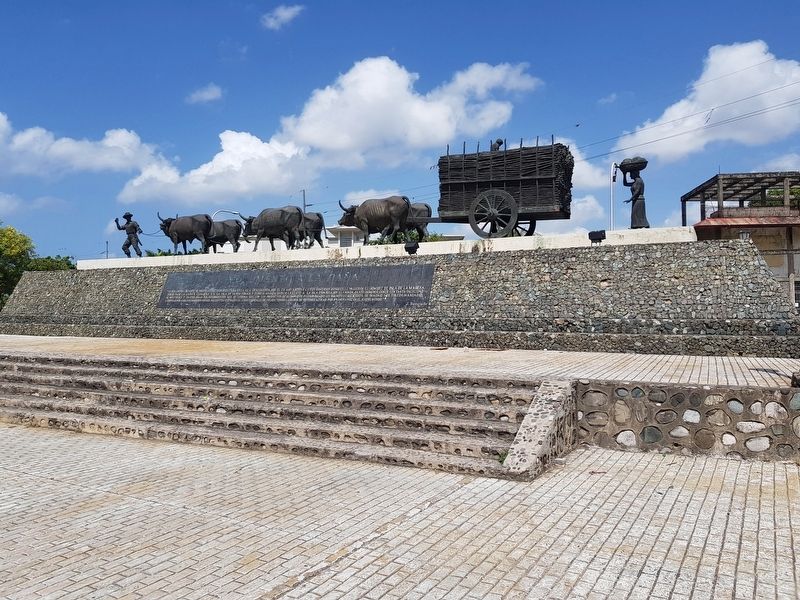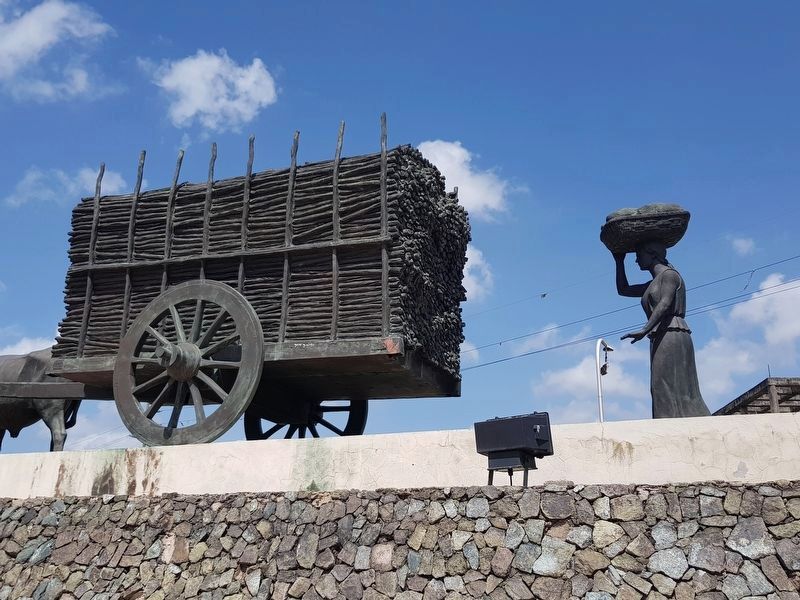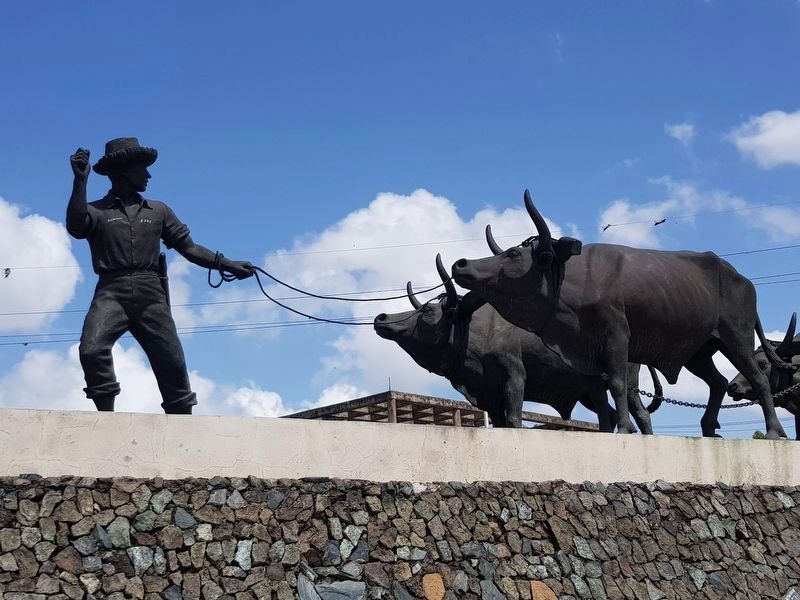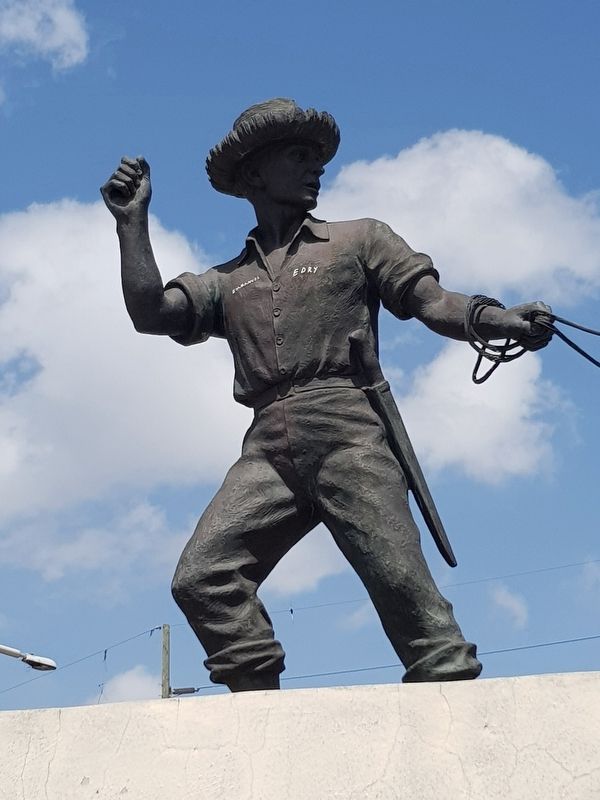Santo Domingo Este, Santo Domingo, Dominican Republic — Caribbean Region of the Americas (Hispaniola, Greater Antilles, West Indies)
The Sugarcane Monument
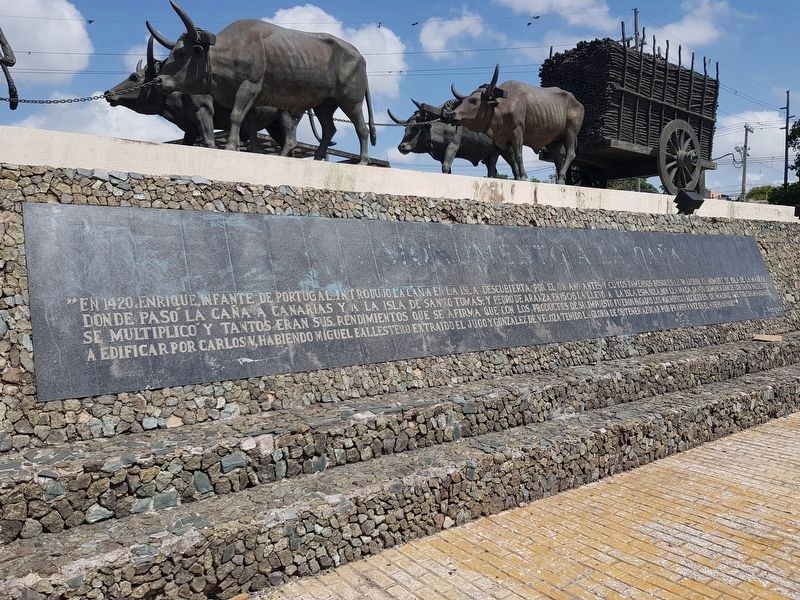
Photographed By J. Makali Bruton, July 11, 2019
1. The Sugarcane Monument
The inscription is large, running the length of a stone base. A large bronze sculpture tops the base of the monument. The sculpture shows a man driving a team of six oxen pulling a sugarcane cart. A woman follows the man and sugar cart.
“En 1420, Enrique Infante de Portugal, introdujo la caña en la isla descubierta por el un año antes y cuyos inmensos bosques le valieron el nombre de Isla de la Madera, donde pasó la caña a Canarias y a la Isla de Santo Tómas; y Pedro de Aranza en 1506 la llevó a la Isla Española, hoy llamada Santo Domingo, donde con tanta felicidad se multiplicó y tantos eran sus rendimientos que se afirma que con los productos de su impuesto fueron pagados los magníficos alcáceres de Madrid y de Toledo, mandados a edificar por Carlos V, habiendo Miguel Ballestero extraído el jugo y González de Veloza tenido la gloria de obtener azúcar por primera vez en el Nuevo Mundo.”
J. Rengade
The Sugarcane Monument
“In 1420, Enrique Infante de Portugal introduced sugarcane on the island discovered by him the year before and whose immense forests earned it the name of Madiera (Wood). He then passed the cane to the Canary Islands and to the island of Santo Tómas. Pedro de Aranza in 1506 then took it to Hispaniola, today called Santo Domingo, where with so much happiness it multiplied and became so profitable that it is affirmed that with the products of taxes paid on sugarcane the magnificent palaces of Madrid and Toledo were built by Carlos V. Later Miguel Ballestero extracted the juice and González de Veloza had the glory of obtaining sugar for the first time in the New World.”
J. Rengade
Erected 1992.
Topics. This historical marker and monument is listed in these topic lists: Agriculture • Industry & Commerce. A significant historical year for this entry is 1420.
Location. 18° 28.757′ N, 69° 52.69′ W. Marker is in Santo Domingo Este, Santo Domingo. Marker is on Avenida España just south of Calle María Trinidad Sánchez, on the right when traveling south. Touch for map. Marker is in this post office area: Santo Domingo Este, Santo Domingo 11602, Dominican Republic. Touch for directions.
Other nearby markers. At least 8 other markers are within walking distance of this marker. Duarte's Return from Exile (approx. half a kilometer away in Distrito Nacional); Admiral Juan Alejandro Acosta (approx. half a kilometer away in Distrito Nacional); Palace of the Viceroy Diego Colón (approx. half a kilometer away in Distrito Nacional); The Atarazanas School (approx. half a kilometer away in Distrito Nacional); Salomé Ureña de Henríquez (approx. half a kilometer away in Distrito Nacional); The Colonial City of Santo Domingo (approx. 0.6 kilometers away in Distrito Nacional); Nicolás de Ovando (approx. 0.6 kilometers away in Distrito Nacional); Palace of the Governors (approx. 0.6 kilometers away in Distrito Nacional).
Also see . . . The Sugar Industry in the Dominican Republic. This article describes the long history of sugar in the Dominican Republic, including early 20th century efforts by US business interests to consolidate control of the industry with the aid of the US military. (Submitted on August 3, 2019, by J. Makali Bruton of Accra, Ghana.)
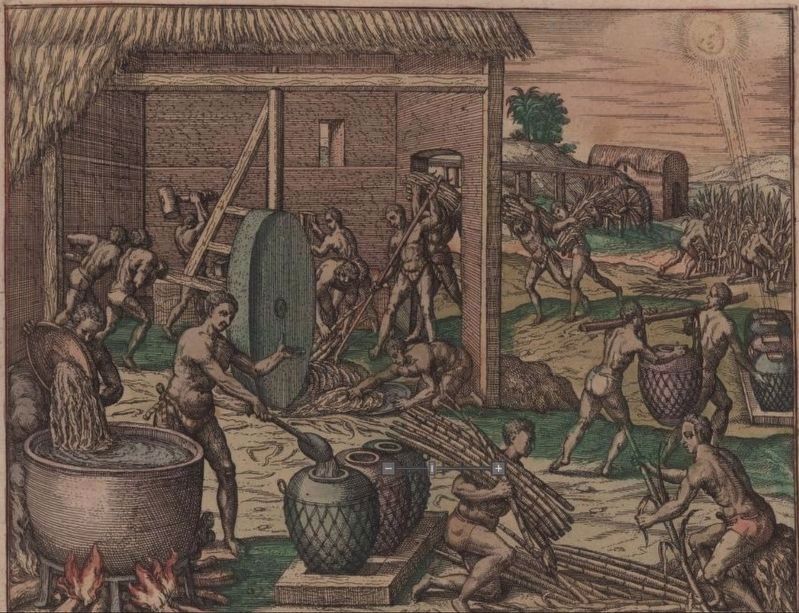
Photographed By Theodore de Bry, 1595
6. The earliest image of sugar production on Hispaniola
In this 1595 engraving by Theodor de Bry, the image shows African slaves processing sugarcane on Hispaniola (today's Haiti and Dominican Republic). Courtesy of the John Carter Brown Library at Brown University.
Credits. This page was last revised on January 25, 2022. It was originally submitted on August 3, 2019, by J. Makali Bruton of Accra, Ghana. This page has been viewed 240 times since then and 23 times this year. Photos: 1, 2, 3, 4, 5, 6. submitted on August 3, 2019, by J. Makali Bruton of Accra, Ghana.
